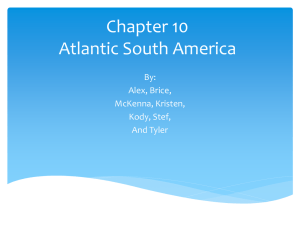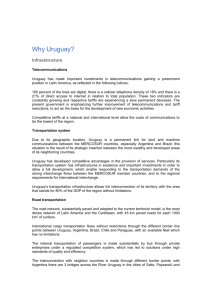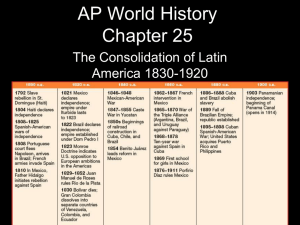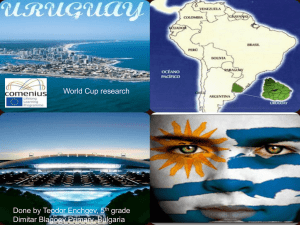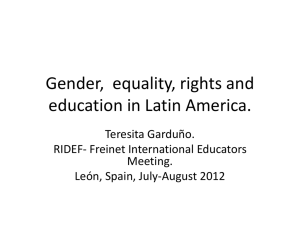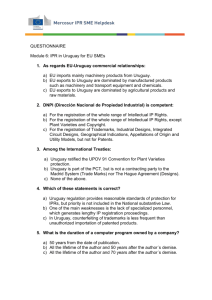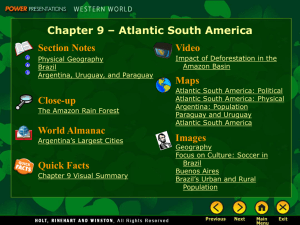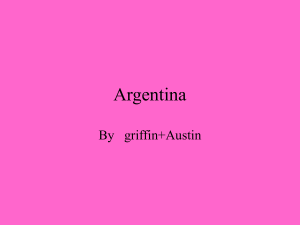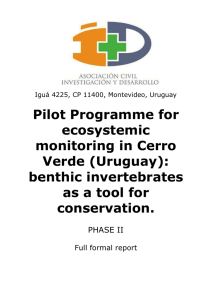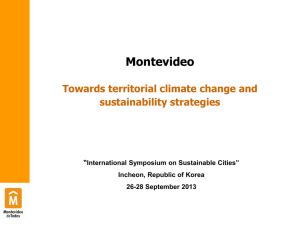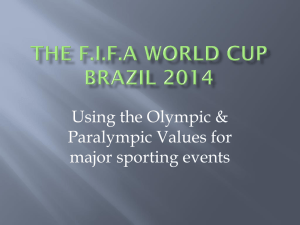The president
advertisement
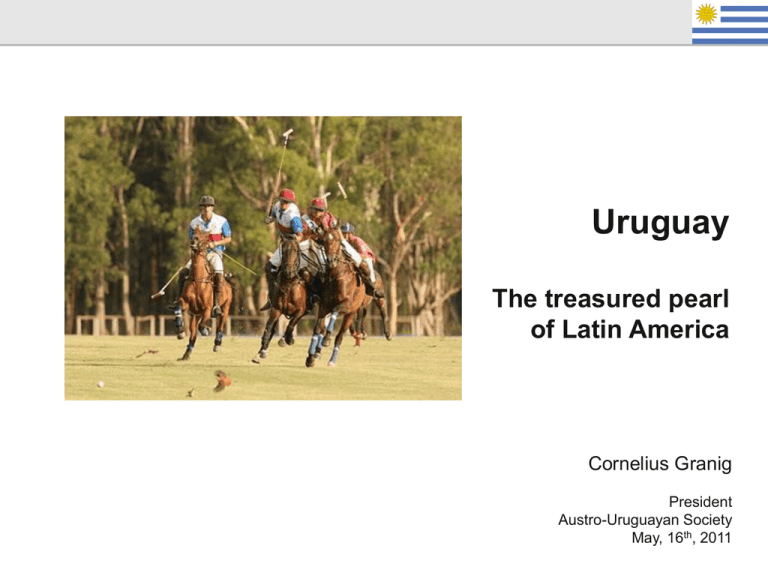
Samoa Uruguay The treasured pearl of Latin America Cornelius Granig President Austro-Uruguayan Society May, 16th, 2011 Agenda 1. Overview 2. History 3. Constitution 4. Political System 5. Challenges Overview A brief overview about Latin America Definition: The region on the American continent in which Romance languages are spoken (Spanish, Portugese) 20 sovereign countries with 600 Mio. inhabitants North America: Central America: Caribic: South America: Mexico Costa Rica, Guatemala, El Salvador, Honduras, Panama, Nicaragua Puerto Rico, Cuba, Dominican Republic Venezuela, Colombia, Ecuador, Peru, Paraguay, Uruguay, Argentina, Chile; Brazil Not part of Latin America are Netherlands Antilles, Haiti, Belize, Surinam, Guayana, French Guayana, other English or French speaking Carribean states Mega-Cities 1. Sao Paulo (19.1 Mio. Inhabitants) – world rank 6 2. Mexico City (18.4) 3. Buenos Aires (12.3) 4. Rio de Janeiro (11.1) 5. Lima (7.7) 6. Bogota (7.4) 7. Santiao de Chile (5.6) 8. Belo Horizonte (4.6) 9. Guadelajara (4) 10. Caracas (2.6) Data from 2008 http://populataion.mongabay.com Languages Spanish Is the main language in 19 of the countries (86 Mio. Mexico, 34 Mio. Colombia, 33 Mio. Argentina, 22 Venezuela, 20 Peru, 10 Cuba, 10 Ecuador, 3 Mio. Uruguay) comparison: spoken in Spain by 28 Mio. people Portuguese spoken in Brazil by 163 Mio. people comparison: spoken in Portugal by 10 Mio. people Many indigenous languages Quechua in Peru, Kichwa in Ecuador, Nahuatl and 62 other in Mexico, 58 in Colombia, Guarani in Paraguay, Mapudungun in Chile, Aymara in Bolovia, Chile and Rapanui International Organisations OAS (Organization of American States) HQ in Washington 35 members (all states on the American continent except Honduras) Cubas suspension was revoked in 2009 Andean Pact (Communidad Andino – CAN) HQ in Lima 4 members (Peru, Colombia, Ecuador, Bolivia) associated Argentina, Brayil, Paraguay, Uruguay, Chile MERCOSUR (Mercado Común del Sur) HQ in Montevideo 5 members (Argentina, Brazil, Paraguay, Uruguay, Venezuela) associated Bolivia, Chile, Colombia, Ecuador, Peru free trade partners: Egypt, Israel What is special about most of the countries Indigenous languages coexist with Spanish/Portugese Almost all countries had a military government in the 1970s/80s Almost all countries saw a move to left-winged governments in the last 10 years Guerilla movements have dramatically decreased Overview Uruguay Where is the Eastern Republic of Uruguay? In the north of Argentina (30 min. flight from Buenos Aires to Montevideo) In the south of Brazil, on the Atlantic coast 20 hours from Kiev (due to 2 stops) Very flat, small country 176.000 square km, capital Montevideo 3.5 Mio. inhabitants Almost half in the capital Very well developed country Peso is the national currency Best rated in life/human development in Latin America 2nd least corrupt country in Latin America (after Chile) 4 times soccer champion (1924-1928-1930-1950) History of Uruguay 1680 Colonel del Sacramento founded by Portugese 18th century Foundation of Montevideo by the Spanish 1830 Independence after a struggle between Argentina, Brayil and Spain 1903-1907 Josef Batlle y Ordonez president 1st WW Uruguay in the war against Germany 2nd WW Uruguay in the war against Germany – broke diplomatic relations with them like 21 other latin american countries (except Argentina) History of Uruguay 1960 The urban guerilla Tupamaros emerges 1968 Jose Pacheco declares state of emergency 1972 Juan Maria Bordaberry became president and after 1973-1976 dictator 1976-1981 Aparicia Mendez leads the civic-military government 1980 Referendum to return to democracy 1981-1985 General Gregorio Conrado Alvarez de facto president and military dictator History of Uruguay 1985-1990 Julio Maria Sanguetti president (second term 1995-2000) Return to democracy 2000-2005 Jose Batlle Ibanez (junior) as Urugays last president from the Colorados 2005-2010 Tabare Vazquez – first left winged president (Frente Amplio) 2011- José Mujica, a former Tupamaro fighter, becomes president Operation ”Condor” A campaign of political repression involving assassination and intelligence operations implemented in 1975 by the right-winged dictators of Argentina, Chile, Uruguay, Paraguay, Bolivia and Brazil. The US was most likely supervising that. Uruguayans were kidnapped and brought to Brazil and (and some to Argentina) – where they were tortured, and some even killed. 300 people disappeared. Constitution and country setup Constitution from 1967 (based on 1930 version) Presidential representative democratic republic Centralized parliament Two chambers of the General Assembly Supreme court is the highest court Judges elected for 10 years by the General Assembly Direct Democracy Changes of the constitution by referendum The president Since 2010 José Mujica - Elected by direct popular election Is head of state and head of the government 5 years in office, without possible immediate re-election - Commander-In-Chief of the army Has the right to veto against laws - Can declare the state of emergency Prepares the state budget President was 10 years in jail - - better known as “El Pepe” was a leader of the Tupamaros National Liberation Movement, a revolutionary group that, like Robin Hood, robbed from rich businesses and banks drives by himself in a Volkswagen Beetle to the office donates 87% of his salary to poor people The vice president Since 2010 Danilo Astori - elected by the public together with the president - in case of the absence of the president, his office is exercised - Former minister of economy He is the leader of the Asamblea Urugay party, which is a social democratic party, and part of the ruling Frente Amplio - Relatively unimportant political position with no big history Since 1934 in the constitution - The parliament (Asamblea General) Chamber of Deputies - 99 members Elected for 5 years Proportional representation Chamber of Senators - 31 members 30 members elected for a 5 year term and the vice president The last election was in 2009. Political parties - Broad Front (Frente Amplio) – left winged coalition National Party (Blancos) – right-winged conservative party Colorado Party (unites a conservative, moderate and social democratic group of votes) Economy In the shadow of the Argentina crisis - 2002 big economy crisis, after Argentina collapsed (-12% GDP) but Uruguayan beef is a worldwide brand Uruguayan wine out of Tannat grapes is a best-seller - well educated workforce for IT offshore industry Tourism is growing Important trading partners - Exports: Brazil (20%), China 9.45, Argentina 8, Germany 5 Imports: Argentina (20%), Brazil 17, China 10, US 10 Financial system and currency - Peso Uruguayo is the national currency No dollar fixing since 2002 (at this time the currency lost 90%) dual system of national and offshore banks Economic overview – MERCOSUR states Country Inhabitants Mill. sq km BIP % Argentina 31.9 2.767 11.9 Bolivia 7.1 1.099 0.7 Brazil 147.4 8.512 38.7 Chile 13 0.757 3.4 Paraguay 4.2 0.407 0.7 Uruguay 3.1 0.177 1.1 Latin America 427.3 19.949 sq km 100% Source: Inter-American Development Bank, 1990 (Mercosur members and associated states Chile and Bolivia) Social welfare “Switzerland” of South America - This dramatically changed after 2002 (e. g. poverty of children increased between 1999 from 11% to 24% in 2002) Social spending is still among the highest in the region Challenges Economic crisis, and the fight against it (Uruguay was almost bankrupt in 2002) Conflicts with Argentina Sellout of water-reserves of Montevideo (Guarani) and other state-owned companies Poor people, who live from waste collection Punishment for the heads of the military dictatorship How to enjoy Uruguay Milonga The tango comes from Uruguay (the Argentinians deny it) – Milongas are dancing events that start at midnight, all over the country. Candombe Is the psychodelic drum music of the descendants of the slaves, that came in the 18th century. Almost all over the year, people gather in Montevideo and walk with their drums through the city. Punta del Este Is the “Marbella” of Latin America. Mate tea Is a “social” drink, that everybody has with him on the street or on the beach. Best known things Dulce de lecche A very thick caramel based spread. Uruguayan beef The best part of Asado. Ruben Rada “Quien VA A Cantar”. NTVG (No te va gustar) “Sólo De Noche”. Polo A team sport for horse lovers. About me Cornelius Granig President of the Austro-Uruguayan Society Studies Political Science (University of Vienna) e-Government and New Public Management (Danube University Krems) Banking (Kiev) Professional Experience Started as radio and print journalist Since 15 years manager in international companies In Ukraine since 2008 Deputy Chairman of the Board of Raiffeisen Bank Aval, Kiev Contact details Thank you! cornelius.granig@gmail.com http://www.uruguay.at
